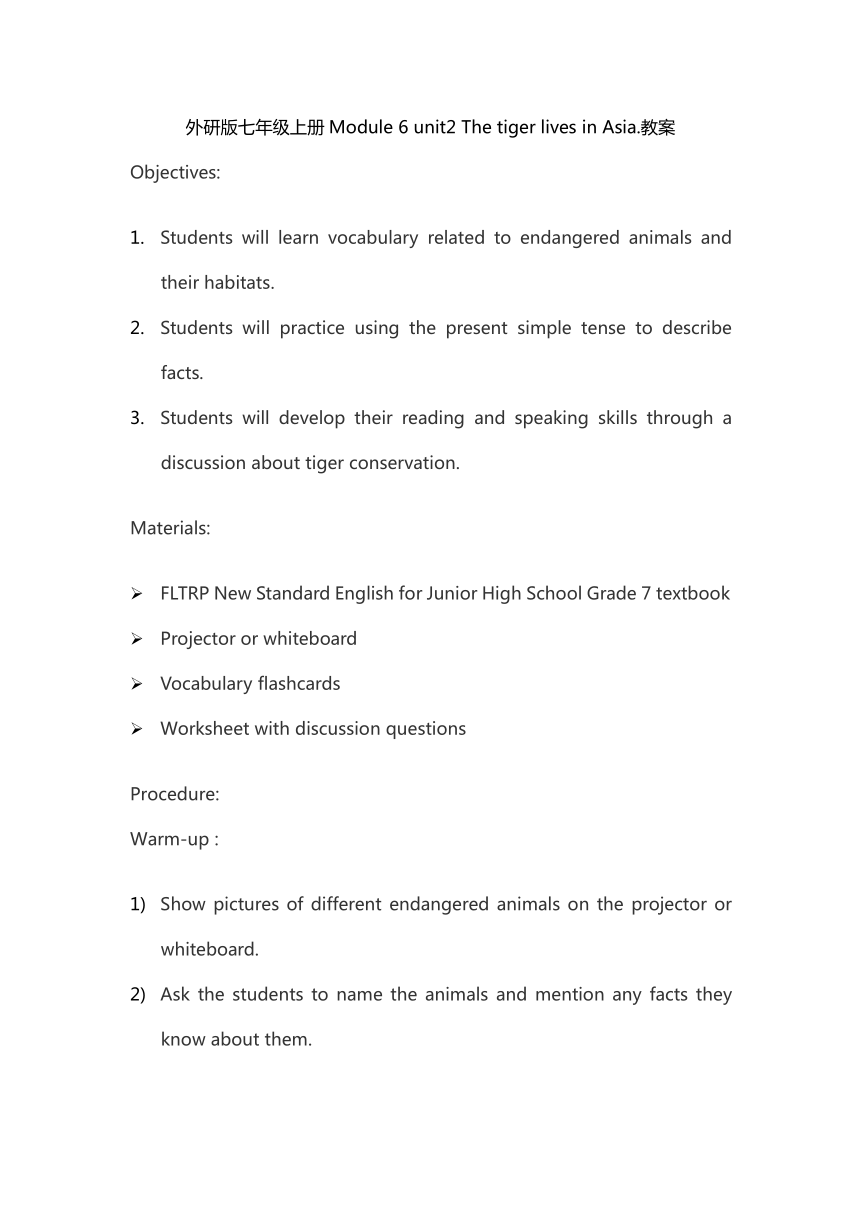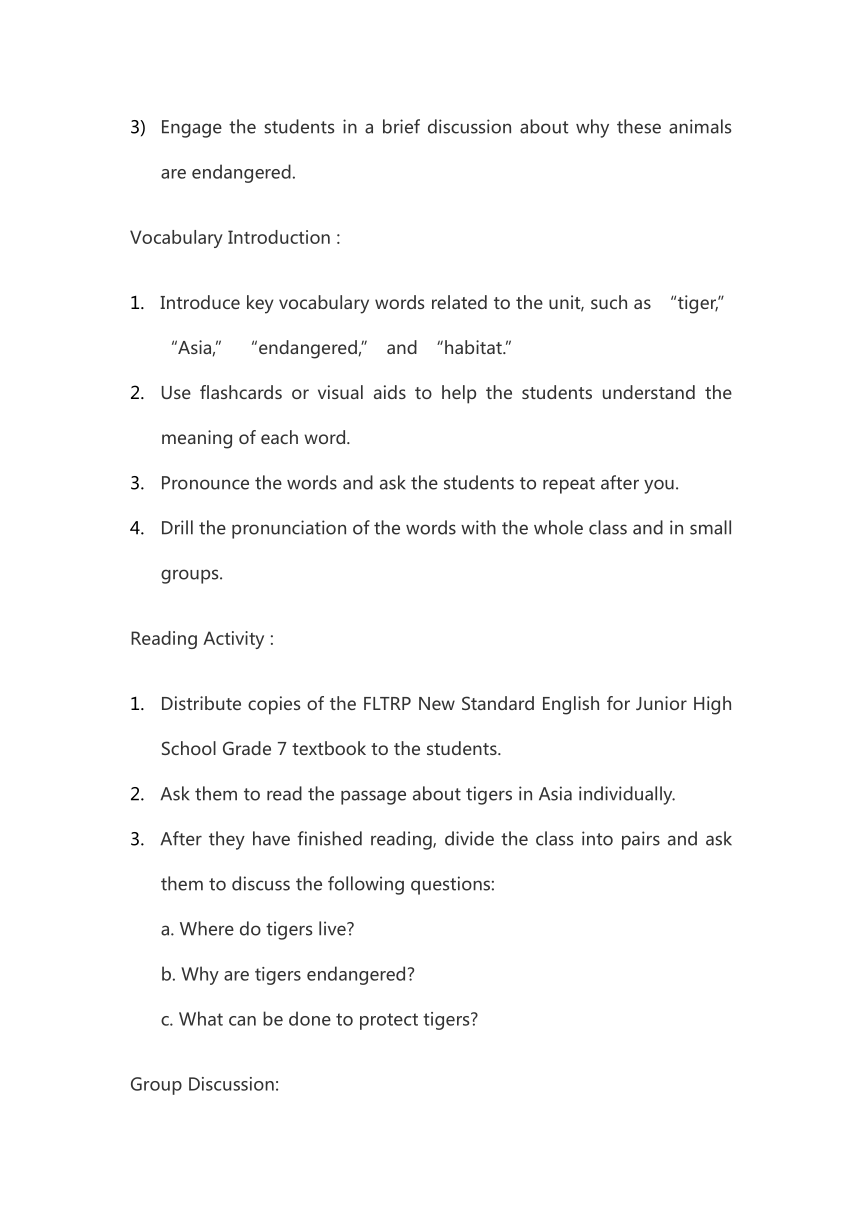Module 6 unit2 The tiger lives in Asia.教案 2023-2024学年外研版英语七年级上册
文档属性
| 名称 | Module 6 unit2 The tiger lives in Asia.教案 2023-2024学年外研版英语七年级上册 |  | |
| 格式 | docx | ||
| 文件大小 | 18.4KB | ||
| 资源类型 | 教案 | ||
| 版本资源 | 外研版 | ||
| 科目 | 英语 | ||
| 更新时间 | 2023-07-21 08:45:34 | ||
图片预览


文档简介
外研版七年级上册Module 6 unit2 The tiger lives in Asia.教案
Objectives:
Students will learn vocabulary related to endangered animals and their habitats.
Students will practice using the present simple tense to describe facts.
Students will develop their reading and speaking skills through a discussion about tiger conservation.
Materials:
FLTRP New Standard English for Junior High School Grade 7 textbook
Projector or whiteboard
Vocabulary flashcards
Worksheet with discussion questions
Procedure:
Warm-up :
Show pictures of different endangered animals on the projector or whiteboard.
Ask the students to name the animals and mention any facts they know about them.
Engage the students in a brief discussion about why these animals are endangered.
Vocabulary Introduction :
Introduce key vocabulary words related to the unit, such as “tiger,” “Asia,” “endangered,” and “habitat.”
Use flashcards or visual aids to help the students understand the meaning of each word.
Pronounce the words and ask the students to repeat after you.
Drill the pronunciation of the words with the whole class and in small groups.
Reading Activity :
Distribute copies of the FLTRP New Standard English for Junior High School Grade 7 textbook to the students.
Ask them to read the passage about tigers in Asia individually.
After they have finished reading, divide the class into pairs and ask them to discuss the following questions:
a. Where do tigers live
b. Why are tigers endangered
c. What can be done to protect tigers
Group Discussion:
Bring the students back together as a whole class and facilitate a discussion based on the questions asked in the previous activity.
Encourage the students to share their thoughts and opinions on tiger conservation.
Guide the discussion and provide additional information, if needed, to expand their understanding of the topic.
Wrap-up:
Summarize the main points discussed during the class.
Provide a brief overview of the importance of protecting endangered animals.
Encourage the students to take small actions in their daily lives to contribute to wildlife conservation efforts.
Homework (optional):
Assign a writing task where students can research and write a short paragraph about an endangered animal of their choice.
Alternatively, ask the students to create a poster or presentation about tiger conservation.
Vocabulary Review:
Review the key vocabulary words from the unit by playing a vocabulary game such as “Guess the Word” or “Charades.”
Divide the class into two teams and take turns giving verbal clues or acting out the vocabulary words.
The team that guesses the word correctly earns a point.
Grammar Practice:
Review the present simple tense with the students.
Write example sentences on the board, such as “The tiger lives in Asia” or “Tigers are endangered.”
Ask the students to identify the verb tense and establish its pattern.
Provide additional examples and ask the students to form their own sentences using the present simple tense to describe animals and their habitats.
Role-playing Activity:
Divide the class into small groups and assign each group a specific role, such as zookeepers, animal rights activists, or government officials.
Ask the groups to create a role-play scenario where they discuss strategies for protecting endangered animals like tigers.
Encourage the students to use the vocabulary and grammar patterns covered in the lesson.
Closure :
Recap the main points of the lesson, including the vocabulary words, grammar structures, and the importance of tiger conservation.
Provide positive feedback and praise for the students’ participation.
Homework (optional):
Assign students to conduct further research on endangered species and create a presentation or poster to raise awareness about the issue.
Alternatively, encourage them to write a short essay describing why it is crucial to protect endangered animals and suggesting ways individuals can contribute to conservation efforts.
Objectives:
Students will learn vocabulary related to endangered animals and their habitats.
Students will practice using the present simple tense to describe facts.
Students will develop their reading and speaking skills through a discussion about tiger conservation.
Materials:
FLTRP New Standard English for Junior High School Grade 7 textbook
Projector or whiteboard
Vocabulary flashcards
Worksheet with discussion questions
Procedure:
Warm-up :
Show pictures of different endangered animals on the projector or whiteboard.
Ask the students to name the animals and mention any facts they know about them.
Engage the students in a brief discussion about why these animals are endangered.
Vocabulary Introduction :
Introduce key vocabulary words related to the unit, such as “tiger,” “Asia,” “endangered,” and “habitat.”
Use flashcards or visual aids to help the students understand the meaning of each word.
Pronounce the words and ask the students to repeat after you.
Drill the pronunciation of the words with the whole class and in small groups.
Reading Activity :
Distribute copies of the FLTRP New Standard English for Junior High School Grade 7 textbook to the students.
Ask them to read the passage about tigers in Asia individually.
After they have finished reading, divide the class into pairs and ask them to discuss the following questions:
a. Where do tigers live
b. Why are tigers endangered
c. What can be done to protect tigers
Group Discussion:
Bring the students back together as a whole class and facilitate a discussion based on the questions asked in the previous activity.
Encourage the students to share their thoughts and opinions on tiger conservation.
Guide the discussion and provide additional information, if needed, to expand their understanding of the topic.
Wrap-up:
Summarize the main points discussed during the class.
Provide a brief overview of the importance of protecting endangered animals.
Encourage the students to take small actions in their daily lives to contribute to wildlife conservation efforts.
Homework (optional):
Assign a writing task where students can research and write a short paragraph about an endangered animal of their choice.
Alternatively, ask the students to create a poster or presentation about tiger conservation.
Vocabulary Review:
Review the key vocabulary words from the unit by playing a vocabulary game such as “Guess the Word” or “Charades.”
Divide the class into two teams and take turns giving verbal clues or acting out the vocabulary words.
The team that guesses the word correctly earns a point.
Grammar Practice:
Review the present simple tense with the students.
Write example sentences on the board, such as “The tiger lives in Asia” or “Tigers are endangered.”
Ask the students to identify the verb tense and establish its pattern.
Provide additional examples and ask the students to form their own sentences using the present simple tense to describe animals and their habitats.
Role-playing Activity:
Divide the class into small groups and assign each group a specific role, such as zookeepers, animal rights activists, or government officials.
Ask the groups to create a role-play scenario where they discuss strategies for protecting endangered animals like tigers.
Encourage the students to use the vocabulary and grammar patterns covered in the lesson.
Closure :
Recap the main points of the lesson, including the vocabulary words, grammar structures, and the importance of tiger conservation.
Provide positive feedback and praise for the students’ participation.
Homework (optional):
Assign students to conduct further research on endangered species and create a presentation or poster to raise awareness about the issue.
Alternatively, encourage them to write a short essay describing why it is crucial to protect endangered animals and suggesting ways individuals can contribute to conservation efforts.
同课章节目录
- Starte
- Module 1 My teacher and my friends
- Module 2 My English lesson
- Module 3 My English book
- Module 4 My everyday life
- Module 1 My classmates
- Unit 1 Nice to meet you.
- Unit 2 I'm Wang Lingling and I'm thirteen years ol
- Unit 3 Language in use.
- Module 2 My family
- Unit 1 Is this your mum?
- Unit 2 These are my parents.
- Unit 3 Language in use.
- Module 3 My school
- Unit 1 There are thirty students in my class.
- Unit 2 The library is on the left of the playgroun
- Unit 3 Language in use.
- Module 4 Healthy food
- Unit 1 We've got lots of apples.
- Unit 2 Is your food and drink healthy?
- Unit 3 Language in use.
- Module 5 My school day
- Unit 1 I love history.
- Unit 2 We start work at nine o'clock.
- Unit 3 Language in use.
- Revision module A
- Module 6 A trip to the zoo
- Unit 1 Does it eat meat?
- Unit 2 The tiger lives in Asia.
- Unit 3 Language in use.
- Module 7 Computers
- Unit 1 How do I write my homework on the computer?
- Unit 2 When do you use a computer?
- Unit 3 Language in use.
- Module 8 Choosing presents
- Unit 1 I always like birthday parties.
- Unit 2 She often goes to concerts.
- Unit 3 Language in use.
- Module 9 People and places
- Unit 1 We're enjoying the school trip a lot.
- Unit 2 They're waiting for buses or trains.
- Unit 3 Language in use.
- Module 10 Spring Festival
- Unit 1 Are you getting ready for Spring Festival?
- Unit 2 My mother's cleaning our houses and sweepin
- Unit 3 Language in use.
- Revision module B
